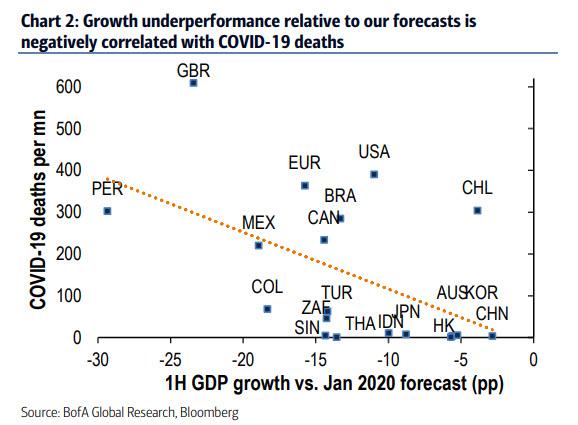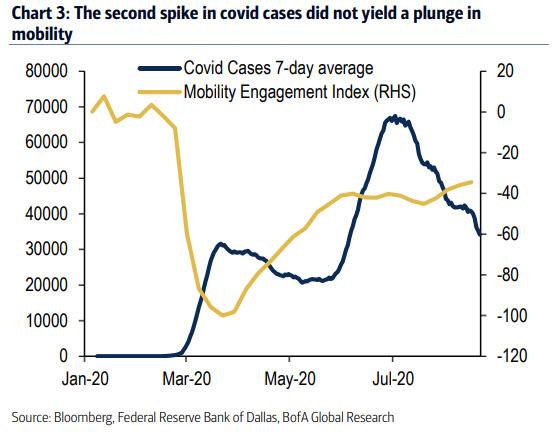When discussing long-term solutions to the covid pandemic, which is clearly not going to go away on its own while about half the population may refuse to be vaccinated, epidemiologists argue that if 60% or more of the population gains immunity the disease can be contained without policy actions. However, according to Bank of America’s latest assessment, even under the most optimistic assumptions relatively few communities are approaching “herd immunity.”
As BofA chief economist Ethan Harris writes, consider the extreme example of New York City, which has recorded 236,647 cases and 23,720 deaths due to COVID. That amounts to 2.7% and 0.3% of the population respectively. Clearly the number of true infections is much higher than the recorded cases due to low testing rates early in the crisis. So let’s focus on the more reliable death statistics.
By making assumptions about the true death rate from the disease, BofA backs out the implied infection rate. Thus if the true death rate is 0.5% (which in light of co-morbidities may be far higher than the real rate) then the true number of infections is 4.7 million (= 23,720/.005). That amounts to 54% of population. The good news is that New York might therefore be approaching herd immunity if it could close its borders and assuming true infections almost always create immunity.
Unfortunately, as Harris concludes, at the national level the same calculation suggests that only 12% of the population has immunity, which is far below the critical 60% threshold.
So if herd immunity is out, or at least delayed indefinitely, then what?
As Harris notes next, at times the COVID crisis is presented as a one-for-one trade-off between the economy and public health, although as experience across the world shows “nothing could be further from the truth” and explains:
There is a good reason that China was at first hit the hardest, but has had a V-like recovery: It first denied the crisis and then adopted a very strong mitigation strategy. A similar story applies for a number of other countries in Asia. The US is near the other end of the spectrum, with a poor mitigation strategy. The economy has not done worse than the rest of the world, but that is because of the massive policy stimulus in the US.
To be sure, the fiscal cost of ineffective containment has been extraordinary although we now live in a time when nobody – not even the so-called fiscal hawks dare to discuss the record $3 trillion budget deficit. Looking across the countries for which qoq growth data are available, there is a modest negative correlation between 1H 2020 COVID-19 deaths per capita and GDP underperformance relative to BofA’s forecasts at the start of the year.
The experience within countries also underscores that low-cost mitigation strategies are possible. Thus in the US, BofA notes that the second spike in cases was curbed with relatively moderate changes in behavior, slowing but not stopping the economic recovery. In other words, the first spike in the US was reversed with a dramatic shutdown and drop in mobility, while the second spike has been reversed with a leveling off in mobility statistics. Harris also expects the recent pick-up in European cases to play out in a similar way.
Putting it all together, the argument then becomes that while the virus can – and likely will – come back in a region at any given moment, each round will be less damaging than the last. And while this dampening is not due to herd immunity— which as calculated at 12% above is not nearly enough to contain the spread – instead the dampening occurs “because people learn from experience” and take appropriate measures, while also impacting those who are least susceptible to serious consequences, such as people under 40. This is why, as BofA concludes, for the most part, the second spike in cases in the US was in states that were little impacted in the first spike.
Harris leaves off on somewhat downbeat notes, writing that despite this dampening effect, he sees four reasons to expect some kind of resurgence in cases in the coming months, particularly in countries in the Northern Hemisphere:
- First, we have seen repeatedly what happens when people let their guard down. A recent example is the resurgence in Spain and France during and after the August holiday season. The 7-day average of new cases has surged from a low of around 60 to 7,800 in Spain and 225 to 6,000 in France.
- The second concern is that the disease clearly transmits more readily indoors. After getting used to gathering again, will people take adequate precautions as they move indoors?
- Third, schools are coming back and while children are less vulnerable to the disease, they and school employees can spread it.
- Finally, we wouldn’t be surprised if good news on a vaccine makes people less cautious, particularly in the US, where there
- have been many premature claims of victory.
One final point to make: with the covid pandemic in the US a critical political issue for the upcoming presidential election, we expect a substantial acceleration in new cases if only in the media for public consumption, which we are confident Biden will use as his main trump card, so to speak, in the upcoming presidential debates with Trump.







